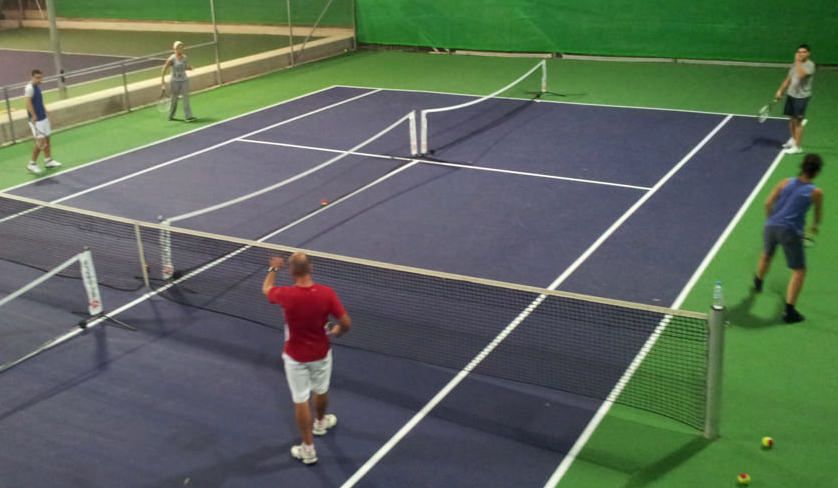Progressive Tennis for Adults

Using Red/Orange/Green modified courts, balls and racquets for kids is becoming the norm world-wide. Having the court size and ball bounce adapted for the size of the participant simply makes sense. That is fine for kids but what about adults? World-wide, there is an issue with players dropping out within 2 years of taking up tennis (70% drop out rate in most countries).
Tennis is found to be tough to play and players don‟t improve fast enough to enjoy the sport (or to get good exercise out of it). They also often don‟t make the social connections that can retain them. The lesson experience can also be boring, especially when traditional, highly technical line feeding processes are employed. Some coaches on the cutting edge have got the brilliant idea that maybe the Progressive Tennis used for kids can also be applied to adult starter players. The thinking is simple, if kids have more success because the ball bounces slower, wouldn‟t adults? In addition, with the court sizes being smaller, adults could evolve their movement skills as well. With tennis easier to learn and play, maybe growing participation and retaining players will improve.
A Successful Program At the Grant Connell Tennis Centre (GCTC) in North Vancouver, BC, this is precisely what is happening. The program is called, Fun Adult Starter Tennis (FAST) and has been used since 2005 to introduce players to the game and stream them into life-long learning and development.The FAST program takes players through an accelerated progression of Red & Orange tennis ending up with Green (tennis on a full court with a 75% compression ball). The schedule is 4 x 2 hour lessons (8 hours total). After the program, players are encouraged to participate in league play with the Green ball. All 1.0-1.5 level programs at the centre use Green balls. The ITF has also created their „Tennis Xpress‟ program using the same progression and similar formatting. Lesson #1: The FAST program starts with players actually attempting to rally on the full court with regular balls. This is an important step to help „sell‟ the progression as it is common for adults to have reservations.
Sometimes, adults feel the progression is only for kids. It also shows that, even though they may think they are playing „real‟ tennis when using a regular ball, it isn‟t very fun. Out of the hundreds of players who have gone through the program, the average rally with regular balls lasts 2 shots. Not an exciting or inspiring activity. The first hour or so of the lesson program has players using Red courts and balls. Participants make frequent comments about how instantly successful and easy play is (especially compared to their regular ball experience at the beginning of the session). In the FAST program, this Red ball time is used to drive home technical fundamentals needed for building a foundation for future improvement. It is also used to expose players to the basic tactics of the game. It is much easier for a coach to get into the relevant details when the ball bounces slower and covering the court isn‟t as challenging.
A number of simple progressions are used to introduce players to all three stroke families (Serve, Groundstrokes, Volleys). The end of the first lesson is just playing Red Tennis which is a great opportunity to introduce rules & scoring and reinforce the tactics. Lesson #2 & 3: The second lesson has players playing from service line to service line and the Orange ball is introduced. The primary activity in all the sessions is players exchanging with each other. This cooperative approach builds rally skills more effectively than basket feeding activities. Players work on receiving the ball which, for starter players, is as important (if not more) than sending skills. The technique learned in lesson #1 is reinforced and adapted for the Orange ball (50% compression of a regular ball). If the players are progressing well, this lesson can jump right into playing on the Orange Court and players would be on the Orange court for both Lessons 2 and 3. The longer court requires the players to adapt their technique for a slightly different task and trajectory of ball.
This adaptation process is important as tennis is a skill that requires technique to be modified for the situation (called “Open Skills”). The Orange ball also helps players solidify their fundamentals. For example, grip changes are introduced in this lesson. The short ¾ sized Orange court, combined with regular service boxes, makes serving easier as well. Lesson #4: The final lesson in the series makes the transition to the Green ball and full size court with the goal to serve, rally, and score. The end of lesson 4 is reserved for learning basic positioning and teamwork for doubles. For starter players, this can be confusing (especially when coupled with the challenge of tennis scoring). Once players can play doubles, a world of tennis opportunity opens for them. Green Ball League Play: At this critical juncture, it is important to funnel players into regular organized play. We have found this dramatically improves retention. Once players are connected with others to enjoy tennis, they are hooked. A Green Ball league follows every FAST Clinic to capture as many participants as possible. Organized play is a „no brainer‟ for players. Your schedule is set (no waiting for, or booking courts), you are connected to a group of players (no phoning around to see who is available), and all the organization is done by a coordinator or coach.
